The 16th Biennial Conference on the Biology of Marine Mammals, San Diego (2005)
Ice-entrapment of Killer Whales in the Sea of Okhotsk
Uni, Yoshikazu1; Aota, Masaaki2; and Tateyama, Kazutaka3
1 Uni's office of Nature-human Interaction Studies
2 Okhotsk Sea Ice Musem of Hokkaido
3 Snow and Ice Research Laboratory, Kitami Institute of Technology
See also Mass Stranding of Killer Whale in Pack Ice at Aidomari, Rause, Hokkaido (Preliminary report)
February 7, 2005
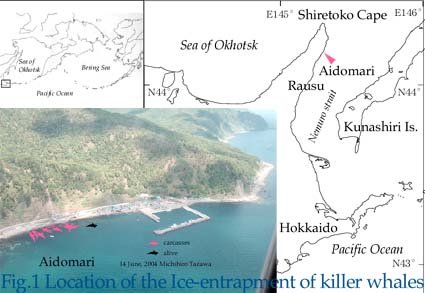 An ice-entrapment of 11–12 killer whales (Orcinus orca) occurred off Aidomari, Rausu, in the Shiretoko peninsula, eastern Hokkaido, Japan (Fig.1). The stranding happened on the first day of the sea ice at shore of the Shiretoko peninsula (Fig.2). The whales died within the day except an adult female escaped to the open water on the next day but a carcass of killer whale was found off Rausu town. We found and got 9 carcasses which consisted of 1 adult male, 5 adult females and 3 calves (1 male and 2 females, they had several birth lines). By the on site dissection, the whales had no evidence of serious injure but one calf had a fracture in his skull, sickness, starvation and parasites to death directory. Our hypothesis was that they killed by physical force of sea ice.
An ice-entrapment of 11–12 killer whales (Orcinus orca) occurred off Aidomari, Rausu, in the Shiretoko peninsula, eastern Hokkaido, Japan (Fig.1). The stranding happened on the first day of the sea ice at shore of the Shiretoko peninsula (Fig.2). The whales died within the day except an adult female escaped to the open water on the next day but a carcass of killer whale was found off Rausu town. We found and got 9 carcasses which consisted of 1 adult male, 5 adult females and 3 calves (1 male and 2 females, they had several birth lines). By the on site dissection, the whales had no evidence of serious injure but one calf had a fracture in his skull, sickness, starvation and parasites to death directory. Our hypothesis was that they killed by physical force of sea ice.
Fig.1. Location of the ice-entrapment of killer whales. Aidomari is the eastern side of the Shiretoko peninsula. It was located in the south end of the Sea of Okhotsk and had

the lowest latitude seasonal sea ice floe, which developed in pelagic water and drifted there.
Fig.2 Sea ice behavior in Feb. 5–8. The pictures indicated concentration of sea ice by color, red as thick, yellow as medium and watery blue as sparse, and dark blue as open water surface and white as no date area.
Brash ice and Spring tide
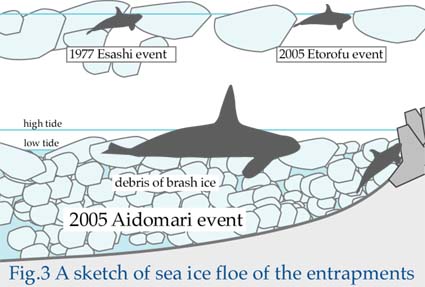
The condition of the sea ice at Aidomari was "brash ice", which was broken ice into pieces between 30cm and 2 m, usually separated from main ice floe. Our idea was that brash ice played key role. The shallow shore area was stuffed with brash ice from the bottom to the surface, then the pod could not escape to open sea. They were stranded not in the sea water but in the sea ice debris, then they were suffocated by their body weight (Fig.3). The whales could not move in parallel direction to the surge. They could only move in right angle to the shore line and set their head to there by physical force of surge with brash ice. And the day was spring tide with 116 cm tidal difference, then the low tide might make their stranding on the ice that caused their suffocation. The high tide was at 12:28 when the fishing boat tried to rescue them but shallow water resisted it.
Fig.3 A sketch of sea ice floe of the entrapments.
Diversity of ice-entrapment
Feb. 27, 2005, another ice-entrapment occurred off Reidovo in the northern coast of Etorofu (Iturup) Island, in the southern Kurils. In this case, condition of sea ice floe was different from Aidomari one (Fig.4). It happened in a blockage by large or main sea ice floe. Then,there were two types of ice-entrapment of killer whales, one was brash ice type, as Aidomari event and the other was blockage type as Etorofu one. Brash ice type happened at tip or chip of main ice floe and die quickly the other one did in the middle of main floe and alive more than a week (Fig.5). In the historical record (Table1), another type was found. 1943 Etorofu event and 1977 Esashi event were caused by re-touch of ice floe so that whales stranded under thick ice cake or rafted ice and died within a few days. It would be the third one, it might be re-touch type.
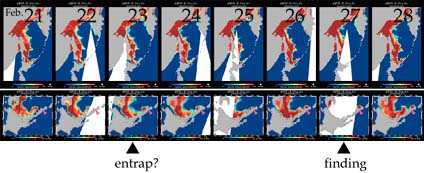 Fig.4 Sea ice behavior to the Etorofu event By the satellite picture, it was different from the Aidomari event that the sea ice behavior to the Etorofu event. The pictures depicted that the first day of sea ice at shore off Reidovo was Feb. 22 or 23, and the ice-entrapment had occurred in offshore on the same day, probably. But the finding of the stranding alive was Feb. 27 and the whales died in early March. It would be spending more than 10 days from the first day of the ice-entrapment to their death. This meaned that they were killed by physical force not of brash ice but of thicker ice cake or rafted ice or likely by starvation or other physiological causes.
Fig.4 Sea ice behavior to the Etorofu event By the satellite picture, it was different from the Aidomari event that the sea ice behavior to the Etorofu event. The pictures depicted that the first day of sea ice at shore off Reidovo was Feb. 22 or 23, and the ice-entrapment had occurred in offshore on the same day, probably. But the finding of the stranding alive was Feb. 27 and the whales died in early March. It would be spending more than 10 days from the first day of the ice-entrapment to their death. This meaned that they were killed by physical force not of brash ice but of thicker ice cake or rafted ice or likely by starvation or other physiological causes.
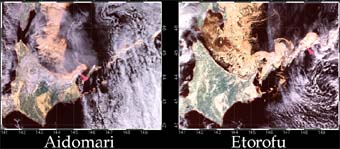
Fig.5 Situations of ice-entrapment in two types
Satellite pictures indicated the two types of distribution of sea ice floe, left: Feb.7, 10:00 am on the day of Aidomari event, right: Feb.27, 10:00 am on the finding day of Etorofu one. The pictures were depicted by temperature in colors, sea ice as ocher, cloud as white, snow as yellow in land, forest as green and sea water as black. There was almost no ice off Aidomari on Feb.7.
All of satellite pictures by Aqua/AMSR-E, sited from the web site of Japan Aerospace Exploration Agency
http://sharaku.eorc.jaxa.jp/cgi-bin/adeos2/seaice/seaice.cgi?lang=j&mode=baknum&y=2005&m=02
Once a decade
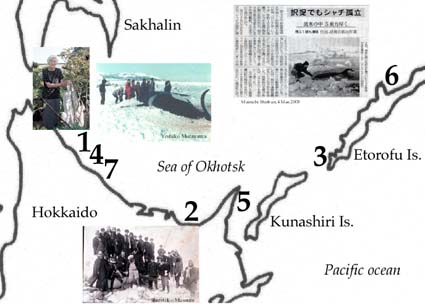
In historical literatures, museum specimens and archives, there were seven events of ice-entrapment of killer whales off Hokkaido and South Kurils from 1925 to 2005 (Fig.5, Table1). All events occurred between February and mid March, and the number of individuals in each pod were 6-13. Furthermore, another two or three events were listed but no evidence now. In folklores of indigenous people Ainu also depicted ice-entrapment of whales in the Shiretoko peninsula. Hunpe-oma-moy, Ainu word means "whale stranding bay" at the east side of the Shiretoko Cape. The Ainu people also referred it happened almost every year and they consumed whale meat and blubber include killer whale. Therefore, the southern area of the Sea of Okhotsk would be high risk area of ice-entrapment for killer whales. It happened almost once in a decade in the area. This was a peculiar feature of that sea.
Fig.6. Distribution of Ice-entrapment of killer whales off Hokkaido
and South Kurils in 1925 - 2005. Numbers refer to Table 1.
Table1. Historical records of Ice-entrapment of Killer Whales off Hokkaido and South Kurils in 1925 - 2005.
No.--date---------location-------------number of animals----note
1----21 Mar 1925--Menashi-tomari, Esashi----13--------------calves included
2----ca. 1940-------Mae-hama, Shari.-------------?
3----18 Mar 1943--Tanne-moy, Etorofu Is.-----13---------------calves included
4----5 Feb 1977---Wen-nay, Esashi---------------8---------------male2, female6; fetus1
5----7 Feb 2005---Aidomari, Rausu----------11 or 12**---------this poster
6----27 Feb 2005--Reidovo, Etorofu Is.----------6
7----ca.1965--------Okajima, Esashi---------------?----------------1 skull preserved*
Source: 1: Kanoh, K. 1994. [Whale?]. Katsuraoka Shizen Shinbun (private print), 25:1-2. Otaru.
2: A photo archives of the Shiretoko Museum
3: Yamada, I. 2000. [Sea Ice of my home Etorofu Is. — Ice-entrapment Whale] . pp. 36–40. In: Okhotsk Culture Group (ed.) [My Sea Ice carry to 21st Century]. Abashiri. also Yamada, I. pers.comm.
4: The Hokkaido Shinbun Feb. 6, 10, 12, 1977. The Asahi shinbun Feb. 6.
5: Observation.
6: The Mainichi Shinbun March 4, 2005. Eremenko, N.(The Natural Reserv Kurilsky) pers.comm.
7: Takabatake, T. ( The Okhotsk museum ESASHI) pers.comm. *Tht skull preserved in the Otaru aquarium.
**DNA analysis indicated that there were another one female and one calf. See poster A.11.6 Kakuda et al. Genetic pod composition of killer whales stranded at Aidomari, Hokkaido on February 7 2005.
Sea ice and "resident"
Contrary to the Sea of Okhotsk, there were less or no ice-entrapment off Atlantic Canada (one or two event in 1941–1984*1), Arctic Canada (no event in 1850–1986*2) and Greenland (no event in 1950–1986*3). Generally, mass stranding of killer whales was thought not common*4. Off sea ice free coast, the Pacific coast of Canada and the Atlantic coast of Norway, there were distinct coastal population "resident" which were evolved with their prey. But no "resident" was known off Hokkaido. Repeating of ice-entrapment caused great mortality so that they had not enough time to develop a residential population? It would be revealed by future works.
Reference
*1Mitchell, E. and Reeves, R. R. 1988. Records of killer whales in the western North Atlantic, with emphasis on eastern Canadian waters. Rit Fiskideildar, 11: 161–193.
*2Reeves, R. R. and Mitchell, E. 1988. Distribution and seasonality of killer whales in the eastern Canadian Arctic. Rit Fiskideildar, 11: 136-160.
*3Heide-Jörgensen, M. 1988. Occurrence and hunting of killer whales in Greenland. Rit Fiskideildar, 11: 115–135.
*4Dahlheim, M. E. and Heyning, J. E. 1988. Killer whale. In: Ridgway, S. H. and Harrison, R. (eds.) Handbook of marine mammals Vol.6, pp. 281–322. Academic press.
Corrected misspelled word on 25 May 2020
 An ice-entrapment of 11–12 killer whales (Orcinus orca) occurred off Aidomari, Rausu, in the Shiretoko peninsula, eastern Hokkaido, Japan (Fig.1). The stranding happened on the first day of the sea ice at shore of the Shiretoko peninsula (Fig.2). The whales died within the day except an adult female escaped to the open water on the next day but a carcass of killer whale was found off Rausu town. We found and got 9 carcasses which consisted of 1 adult male, 5 adult females and 3 calves (1 male and 2 females, they had several birth lines). By the on site dissection, the whales had no evidence of serious injure but one calf had a fracture in his skull, sickness, starvation and parasites to death directory. Our hypothesis was that they killed by physical force of sea ice.
An ice-entrapment of 11–12 killer whales (Orcinus orca) occurred off Aidomari, Rausu, in the Shiretoko peninsula, eastern Hokkaido, Japan (Fig.1). The stranding happened on the first day of the sea ice at shore of the Shiretoko peninsula (Fig.2). The whales died within the day except an adult female escaped to the open water on the next day but a carcass of killer whale was found off Rausu town. We found and got 9 carcasses which consisted of 1 adult male, 5 adult females and 3 calves (1 male and 2 females, they had several birth lines). By the on site dissection, the whales had no evidence of serious injure but one calf had a fracture in his skull, sickness, starvation and parasites to death directory. Our hypothesis was that they killed by physical force of sea ice.

 Fig.4 Sea ice behavior to the Etorofu event By the satellite picture, it was different from the Aidomari event that the sea ice behavior to the Etorofu event. The pictures depicted that the first day of sea ice at shore off Reidovo was Feb. 22 or 23, and the ice-entrapment had occurred in offshore on the same day, probably. But the finding of the stranding alive was Feb. 27 and the whales died in early March. It would be spending more than 10 days from the first day of the ice-entrapment to their death. This meaned that they were killed by physical force not of brash ice but of thicker ice cake or rafted ice or likely by starvation or other physiological causes.
Fig.4 Sea ice behavior to the Etorofu event By the satellite picture, it was different from the Aidomari event that the sea ice behavior to the Etorofu event. The pictures depicted that the first day of sea ice at shore off Reidovo was Feb. 22 or 23, and the ice-entrapment had occurred in offshore on the same day, probably. But the finding of the stranding alive was Feb. 27 and the whales died in early March. It would be spending more than 10 days from the first day of the ice-entrapment to their death. This meaned that they were killed by physical force not of brash ice but of thicker ice cake or rafted ice or likely by starvation or other physiological causes.
